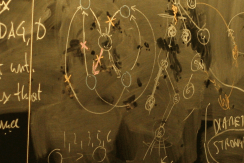GECO Evolutionary and Computational Genomics
The main goal of the GECO department is to foster integration and synergies between theoretical and methodological research relevant for the analysis of genomes (computational genomics) and empirical analysis of genomic and multi-omic data (evolutionary and functional genomics). The department is structured in two teams, BAOBAB and BPGE:
BAOBAB is deeply rooted in computer science. Its strengths are in algorithms, models, and mathematical analysis of graphs and networks, with applications to transcriptomics and metabolic networks.
BPGE is oriented towards bioinformatics, phylogenetics and evolutionary genomics. Its research projects cover a broad range of subjects, such as methodological developments for phylogenetic inference, their applications to the reconstruction of the evolutionary history of bacteria and archaea, the role of mobile genetic elements in the evolution of bacteria and of antibioresistance, or the role of recombination, of genomic rearrangements and of transposable elements in the evolution of eukaryotic genomes.
As detailed on their pages, the research conducted in both teams integrates deep and long-ranging theoretical and methodological (algorithmic and computational) developments with data analysis driven by empirical questions. This integration is bi-directional: methodological developments are guided by empirical questions and then used in empirical applications, while theoretical modeling helps clarify the conceptual basis of subsequent empirical analyses.
Publications
Display of 1171 to 1200 publications on 1415 in total
Use and misuse of correspondence analysis in codon usage studies
Nucleic Acids Research . 30 : 4548-4555
Journal article
see the publicationRecombination rate and the distribution of transposable elements in the Drosophila melanogaster genome
Genome Research . 12 : 400-407
DOI: 10.1101/gr.210802
Journal article
see the publicationWhat is the relevance of obtaining multiple blood samples for culture? A comprehensive model to optimize the strategy for diagnosing bacteremia
Clinical Infectious Diseases . 35 ( 7 ) : 842-850
DOI: 10.1086/342383
Journal article
see the publicationModelling the competitive growth of Listeria monocytogenes and Listeria innocua in enrichment broths
International Journal of Food Microbiology . 73 ( 2-3 ) : 261-274
Journal article
see the publicationArchaeal phylogeny based on ribosomal proteins
Mol Biol Evol . 19 : 631-639
Journal article
see the publicationEubacterial phylogeny based on translational apparatus proteins
Trends in Genetics . 18 ( 1 ) : 1-5
Journal article
see the publicationConflicting phylogeographic patterns in rRNA and nifD indicate regionally restricted gene transfer in Bradyrhizobium.
Microbiology . 148 ( Pt 8 ) : 2557-65
Journal article
see the publicationROSO: A software to search optimized oligonucleotide probes for microarrays
COST853: Agricultural Biomarkers for Array-Technology .
Conference paper
see the publicationROSO : A Software to Search Optimized Oligonucleotide Probes for Microarrays
10. International Conference on Intelligent Systems for Molecular Biology (ISMB) .
Poster
see the publicationVanishing GC-Rich Isochores in Mammalian Genomes
Genetics . 162 : 1837-1848
Journal article
see the publicationComparative sequence analysis of the X-inactivation center region in mouse human and bovine
Genome Research . 12 : 894-908.
Journal article
see the publicationEvolution of synonymous codon usage in metazoans
Current Opinion in Genetics and Development . 12 : 640-649
Journal article
see the publicationCurrent methods of gene prediction their strengths and weaknesses
Nucleic Acids Research . 30 : 4103-4117
Journal article
see the publicationOccurrence probability of structured motifs in random sequences
Journal of Computational Biology . 9 ( 6 ) : 761-773
Journal article
see the publicationA mathematical method for determining genome divergence and species delineation using AFLP
International Journal of Systematic and Evolutionary Microbiology . 52 : 573-586
Journal article
see the publicationA mathematical method for determining genome divergence and species delineation using AFLP
International Journal of Systematic and Evolutionary Microbiology . 52 : 573-586
Journal article
see the publicationNUREBASE: database of nuclear hormone receptors
Nucleic Acids Research . 30 : 364-368
Journal article
see the publicationAutomatic RNA secondary structure prediction with a comparative approach
Journal of Computational Chemistry . 26 ( 5 ) : 521-530
Journal article
see the publicationFunctional and evolutionary analysis of a eukaryotic parasitic genome
Current Opinion in Microbiology . 5 : 499-505
Journal article
see the publicationModeling the Lag Time of Listeria monocytogenes from Viable Count Enumeration and Optical Density Data
Applied and Environmental Microbiology . 68 : 5816-5825
Journal article
see the publicationThe relative abundance of dinucleotides in transposable elements in five species
Molecular Biology and Evolution . 19 : 964-967
Journal article
see the publicationCodon usage by transposable elements and their host genes in five species
Journal of Molecular Evolution . 54 : 625-637
Journal article
see the publicationHill-Robertson interference is a minor determinant of variations in codon bias across Drosophila melanogaster and Caenorhabditis elegans genomes
Molecular Biology and Evolution . 19 : 1399-1406
Journal article
see the publicationHaplotype tests using coalescent simulations conditional on the number of segregating sites
Molecular Biology and Evolution . 18 : 1136-1138
Journal article
see the publicationOrganisation Fonctionnement et Evolution des Génomes de Métazoaires : Mais où est donc passée la sélection naturelle ?
incollection . -- : 287-289
Journal article
see the publicationWhy do genes have introns? Recombination might add a new piece to the puzzle
Trends in Genetics . 17 : 172-175
Journal article
see the publicationAlgorithms for extracting structured motifs using a suffix tree with application to promoter and regulatory site consensus identification
Journal of Computational Biology . 7 ( 1 ) : 345-360
Journal article
see the publicationAnalysis of pFQ31 a 8551-bp cryptic plasmid from the symbiotic nitrogen-fixing actinomycete Frankia
FEMS Microbiology Letters . 197 : 111-116
Journal article
see the publication
